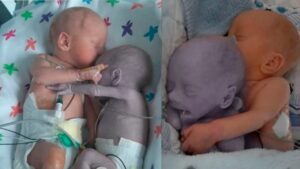15-Month-Old Recovers After Being Bitten Twice by Rattlesnake

A 15-month-old toddler is on the road to recovery after surviving a terrifying double rattlesnake bite incident in a remote area of Arizona, according to family members and hospital officials.

The child, identified as Noah Ramirez, was playing outside near his family’s rural property on the outskirts of Phoenix when the incident occurred late Saturday afternoon. According to his mother, Maria Ramirez, the boy had wandered just a few feet from the back porch when he encountered a western diamondback rattlesnake — one of the most venomous snake species in North America.
“We heard him cry out, and when we ran over, we saw the snake coiled right next to him,” Maria said. “He had already been bitten once on the leg and again on the hand when we got to him.”
Family members immediately called 911 and rushed Noah to Banner University Medical Center, where he was admitted to the pediatric intensive care unit. Emergency responders say Noah was already showing signs of severe envenomation by the time they arrived, including swelling, discoloration, and labored breathing.
Doctors quickly administered antivenom and began aggressive treatment to reduce the spread of venom and stabilize the toddler’s vital signs. Over the next 48 hours, Noah remained in critical condition but showed remarkable signs of improvement after responding well to the antivenom therapy.
“We are incredibly relieved and grateful,” said Dr. Hannah Liu, the lead pediatric toxicologist overseeing Noah’s care. “Being bitten once is dangerous enough — being bitten twice at that age is life-threatening. His recovery is nothing short of miraculous.”
According to hospital staff, Noah has regained full consciousness, is breathing on his own, and has started to move and play again. He is expected to remain under observation for a few more days to monitor for any secondary complications such as infection or tissue damage.
Arizona is home to 13 species of rattlesnakes, and spring through early fall marks their most active period. Wildlife officials say children are especially vulnerable due to their small size and limited ability to recognize danger. Experts recommend maintaining clean, trimmed yards and closely supervising young children when outdoors in rattlesnake-prone areas.
The Ramirez family is now raising awareness about the risks of snake encounters in desert regions. “We never thought something like this would happen so close to home,” said Maria. “We’re just thankful our son is alive — and we want other parents to be vigilant.”
Noah’s survival has been hailed as a testament to swift emergency response and expert medical care. His story has also sparked renewed discussions about the importance of antivenom availability and public education on venomous snake safety in rural communities.





